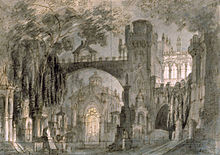 Lucia di Lammermoor A Program of the Organization of Chinese American Women
Lucia di Lammermoor A Program of the Organization of Chinese American Women
Tickets are $45.00 and will be distributed by our Executive Director from 3:20-3:40 PM prior to the performance and then will be placed at will call under the purchaser's last name.
Stellar Cast
Jessica Stecklein - Soprano
Caroline G Gibson -Soprano
Yingxi Zhang - Tenor
Daesan No - Baritone
Kwang Kyu Lee - Bass
Edward Roberts - Conductor
Muriel Von Villas - Stage Director
Ful
Synopsis
Time: Late 17th centuryPlace: Scotland[5][edit]Act 1
Scene 1: The gardens of Lammermoor Castle
Normanno, captain of the castle guard, and other retainers are searching for an intruder. He tells Enrico that he believes that the man is Edgardo, and that he comes to the castle to meet Lucia. It is confirmed that Edgardo is indeed the intruder. Enrico reaffirms his hatred for the family and his determination to end the relationship.
Scene 2: By a fountain at the entrance to the park, beside the castle
Lucia waits for Edgardo. In her famous aria Regnava nel Silenzio, Lucia tells her maid Alisa that she has seen the ghost of a girl killed on the very same spot by a jealous Ravenswood ancestor. Alisa tells Lucia that the apparition is a warning and that she must give up her love for Edgardo. Edgardo enters; for political reasons, he must leave immediately for France. He hopes to make his peace with Enrico and marry Lucia. Lucia tells him this is impossible, and instead they take a sworn vow of marriage and exchange rings. Edgardo leaves.
[edit]Act 2
Scene 1: Lord Ashton's apartments in Lammermoor Castle
Preparations have been made for the imminent wedding of Lucia to Arturo. Enrico worries about whether Lucia will really submit to the wedding. He shows his sister a forged letter seemingly proving that Edgardo has forgotten her and taken a new lover. Enrico leaves Lucia to further persuasion this time by Raimondo, Lucia's chaplain and tutor, that she should renounce her vow to Edgardo, for the good of the family, and marry Arturo.
Scene 2: A hall in the castle
Arturo arrives for the marriage. Lucia acts strangely, but Enrico explains that this is due to the death of her mother. Arturo signs the marriage contract, followed reluctantly by Lucia. At that point Edgardo suddenly appears in the hall. Raimondo prevents a fight, but he shows Lucia's signature on the marriage contract to Edgardo. He curses her, demanding that they return their rings to each other. He tramples his ring on the ground, before being forced out of the castle.
[edit]Act 3
Scene 1: The Wolf's Crag
Enrico visits Edgardo to challenge him to a duel. He tells him that Lucia is already enjoying her bridal bed. Edgardo agrees to fight him. They will meet later by the graveyard of the Ravenswoods, near the Wolf's Crag.
Scene 2: A Hall in Lammermoor Castle
Raimondo interrupts the marriage celebrations to tell the guests that Lucia has gone mad and killed her bridegroom Arturo. Lucia enters. In the aria 'Il dolce suono' she imagines being with Edgardo, soon to be happily married. Enrico enters and at first threatens Lucia but later softens when he realizes her condition. Lucia collapses. Raimondo blames Normanno for precipitating the whole tragedy.
Scene 3: The graveyard of the Ravenswood family
Edgardo is resolved to kill himself on Enrico's sword. He learns that Lucia is dying and then Raimondo comes to tell him that she has already died. Edgardo stabs himself with a dagger, hoping to be reunited with Lucia in heaven.[6]
[edit]Music
[edit]The "Mad Scene"
The "Mad Scene", "Il dolce suono...Spargi d'amaro pianto", has historically been a vehicle for several coloratura sopranos (providing a breakthrough for Dame Joan Sutherland) and is a technically and expressively demanding piece.
Some sopranos, most notably Maria Callas, have performed the scene in a come scritto ("as written") fashion, adding minimal ornamentation to their interpretations. Most sopranos, however, add ornamentation to demonstrate their technical ability, as was the tradition in the bel canto period. This involves the addition and interpolation of trills, mordents, turns, runs and cadenzas. Almost all sopranos append cadenzas to the end of the "Mad Scene", sometimes ending them on a high E-flat. Some sopranos, including Ruth Welting[7] and Mariella Devia[8] have sung the "Mad Scene" in Donizetti's original F major key, ending it with a high F natural instead of transposing it one step down to the E-flat major key.
The original scoring of this scene was for glass harmonica, but this was later replaced by the more usual arrangement with two flutes.
Founded in 1994 by Producer-Director Muriel Hom, Opera International’s mission is to inspire an appreciation of Opera in young people, assist aspiring vocalists in preparation for operatic careers, and offer world-class productions at affordable prices.
Opera International runs an annual production of world-renowned operas to provide opportunities for young artists to perform lead roles alongside established singers who believe in this kind of apprenticeship and who are willing to share their skills to help young singers develop their craft. In addition, each artist is provided with a scholarship to further his or her career.
Over 40 young singers have benefited from working with Opera International and have enjoyed critical acclaim. Many have gone on to perform with leading opera companies, including the New York Metropolitan Opera, New York City Opera, San Francisco Opera, Houston Grand Opera, Seattle Opera, Washington Opera, and the El Paso Opera.
Opera International, a program of the Organization of Chinese American Women, operates under the non-profit status of OCAW, a 501 (c) (3) organization
Click here to buy tickets!!!

